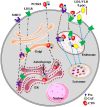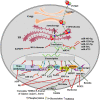Regulation of PCSK9 Expression and Function: Mechanisms and Therapeutic Implications
- PMID: 34782856
- PMCID: PMC8589637
- DOI: 10.3389/fcvm.2021.764038
Regulation of PCSK9 Expression and Function: Mechanisms and Therapeutic Implications
Abstract
Proprotein convertase subtilisin/kexin type 9 (PCSK9) promotes degradation of low-density lipoprotein receptor (LDLR) and plays a central role in regulating plasma levels of LDL cholesterol levels, lipoprotein(a) and triglyceride-rich lipoproteins, increasing the risk of cardiovascular disease. Additionally, PCSK9 promotes degradation of major histocompatibility protein class I and reduces intratumoral infiltration of cytotoxic T cells. Inhibition of PCSK9 increases expression of LDLR, thereby reducing plasma levels of lipoproteins and the risk of cardiovascular disease. PCSK9 inhibition also increases cell surface levels of major histocompatibility protein class I in cancer cells and suppresses tumor growth. Therefore, PCSK9 plays a vital role in the pathogenesis of cardiovascular disease and cancer, the top two causes of morbidity and mortality worldwide. Monoclonal anti-PCSK9 antibody-based therapy is currently the only available treatment that can effectively reduce plasma LDL-C levels and suppress tumor growth. However, high expenses limit their widespread use. PCSK9 promotes lysosomal degradation of its substrates, but the detailed molecular mechanism by which PCSK9 promotes degradation of its substrates is not completely understood, impeding the development of more cost-effective alternative strategies to inhibit PCSK9. Here, we review our current understanding of PCSK9 and focus on the regulation of its expression and functions.
Keywords: LDL receptor; PCSK9; atherosclerosis; cancer immunotherapy; cardiovascular disease; lipid metabolism; major histocompatibility protein class I.
Copyright © 2021 Xia, Peng, Gu, Wang, Wang and Zhang.
Conflict of interest statement
The authors declare that the research was conducted in the absence of any commercial or financial relationships that could be construed as a potential conflict of interest.
Figures


Similar articles
-
Targeting the proprotein convertase subtilisin/kexin type 9 for the treatment of dyslipidemia and atherosclerosis.J Am Coll Cardiol. 2013 Oct 15;62(16):1401-8. doi: 10.1016/j.jacc.2013.07.056. Epub 2013 Aug 21. J Am Coll Cardiol. 2013. PMID: 23973703 Review.
-
Proprotein Convertase Subtilisin/Kexin-Type 9 and Lipid Metabolism.Adv Exp Med Biol. 2020;1276:137-156. doi: 10.1007/978-981-15-6082-8_9. Adv Exp Med Biol. 2020. PMID: 32705598 Review.
-
Cyclase-associated protein 1 is a binding partner of proprotein convertase subtilisin/kexin type-9 and is required for the degradation of low-density lipoprotein receptors by proprotein convertase subtilisin/kexin type-9.Eur Heart J. 2020 Jan 7;41(2):239-252. doi: 10.1093/eurheartj/ehz566. Eur Heart J. 2020. PMID: 31419281 Free PMC article.
-
Proprotein convertase subtilisin kexin type 9 promotes intestinal overproduction of triglyceride-rich apolipoprotein B lipoproteins through both low-density lipoprotein receptor-dependent and -independent mechanisms.Circulation. 2014 Jul 29;130(5):431-41. doi: 10.1161/CIRCULATIONAHA.113.006720. Epub 2014 May 23. Circulation. 2014. PMID: 25070550 Free PMC article.
-
Structure and Function of Proprotein Convertase Subtilisin/kexin Type 9 (PCSK9) in Hyperlipidemia and Atherosclerosis.Curr Drug Targets. 2019;20(10):1029-1040. doi: 10.2174/1389450120666190214141626. Curr Drug Targets. 2019. PMID: 30767742 Review.
Cited by
-
Genetic Variants, Bioactive Compounds, and PCSK9 Inhibitors in Hyper-LDL-Cholesterolemia: A GWAS and In Silico Study on Cardiovascular Disease Risk.Nutrients. 2025 Apr 23;17(9):1411. doi: 10.3390/nu17091411. Nutrients. 2025. PMID: 40362720 Free PMC article.
-
Computational Design and Biological Evaluation of Analogs of Lupin Peptide P5 Endowed with Dual PCSK9/HMG-CoAR Inhibiting Activity.Pharmaceutics. 2022 Mar 18;14(3):665. doi: 10.3390/pharmaceutics14030665. Pharmaceutics. 2022. PMID: 35336039 Free PMC article.
-
Management of High-Risk Hypercholesterolemic Patients and PCSK9 Inhibitors Reimbursement Policies: Data from a Cohort of Italian Hypercholesterolemic Outpatients.J Clin Med. 2022 Aug 11;11(16):4701. doi: 10.3390/jcm11164701. J Clin Med. 2022. PMID: 36012937 Free PMC article.
-
Causal relationship between lipid-lowering drugs and ovarian cancer, cervical cancer: a drug target mendelian randomization study.BMC Cancer. 2024 May 31;24(1):667. doi: 10.1186/s12885-024-12434-z. BMC Cancer. 2024. PMID: 38822303 Free PMC article.
-
PCSK9 with a gain of function D374Y mutation aggravates atherosclerosis by inhibiting PPARα expression.Sci Rep. 2025 Feb 26;15(1):6941. doi: 10.1038/s41598-025-91061-5. Sci Rep. 2025. PMID: 40011664 Free PMC article.
References
Publication types
LinkOut - more resources
Full Text Sources
Miscellaneous

